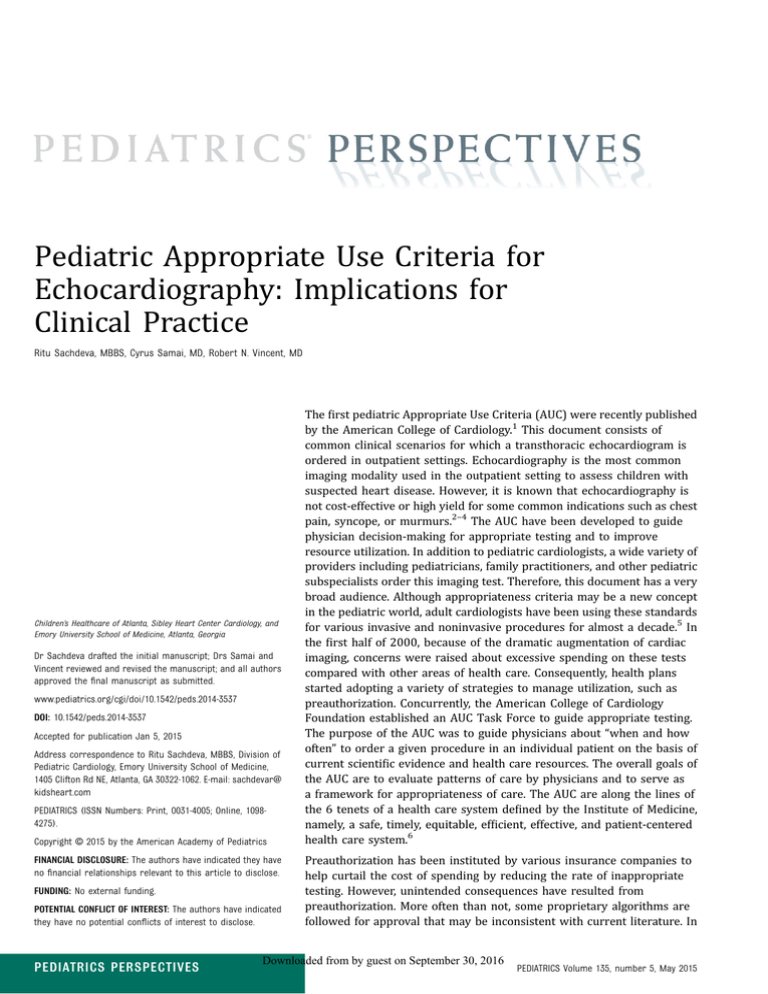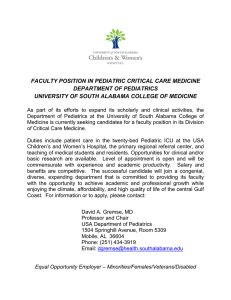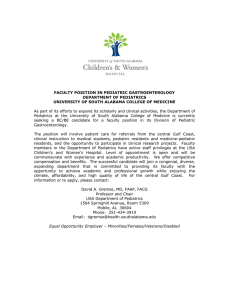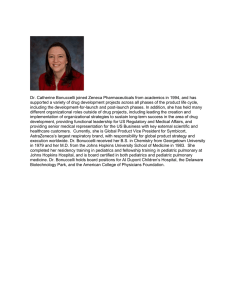
Pediatric Appropriate Use Criteria for
Echocardiography: Implications for
Clinical Practice
Ritu Sachdeva, MBBS, Cyrus Samai, MD, Robert N. Vincent, MD
Children’s Healthcare of Atlanta, Sibley Heart Center Cardiology, and
Emory University School of Medicine, Atlanta, Georgia
Dr Sachdeva drafted the initial manuscript; Drs Samai and
Vincent reviewed and revised the manuscript; and all authors
approved the final manuscript as submitted.
www.pediatrics.org/cgi/doi/10.1542/peds.2014-3537
DOI: 10.1542/peds.2014-3537
Accepted for publication Jan 5, 2015
Address correspondence to Ritu Sachdeva, MBBS, Division of
Pediatric Cardiology, Emory University School of Medicine,
1405 Clifton Rd NE, Atlanta, GA 30322-1062. E-mail: sachdevar@
kidsheart.com
PEDIATRICS (ISSN Numbers: Print, 0031-4005; Online, 10984275).
Copyright © 2015 by the American Academy of Pediatrics
FINANCIAL DISCLOSURE: The authors have indicated they have
no financial relationships relevant to this article to disclose.
FUNDING: No external funding.
POTENTIAL CONFLICT OF INTEREST: The authors have indicated
they have no potential conflicts of interest to disclose.
PEDIATRICS PERSPECTIVES
The first pediatric Appropriate Use Criteria (AUC) were recently published
by the American College of Cardiology.1 This document consists of
common clinical scenarios for which a transthoracic echocardiogram is
ordered in outpatient settings. Echocardiography is the most common
imaging modality used in the outpatient setting to assess children with
suspected heart disease. However, it is known that echocardiography is
not cost-effective or high yield for some common indications such as chest
pain, syncope, or murmurs.2–4 The AUC have been developed to guide
physician decision-making for appropriate testing and to improve
resource utilization. In addition to pediatric cardiologists, a wide variety of
providers including pediatricians, family practitioners, and other pediatric
subspecialists order this imaging test. Therefore, this document has a very
broad audience. Although appropriateness criteria may be a new concept
in the pediatric world, adult cardiologists have been using these standards
for various invasive and noninvasive procedures for almost a decade.5 In
the first half of 2000, because of the dramatic augmentation of cardiac
imaging, concerns were raised about excessive spending on these tests
compared with other areas of health care. Consequently, health plans
started adopting a variety of strategies to manage utilization, such as
preauthorization. Concurrently, the American College of Cardiology
Foundation established an AUC Task Force to guide appropriate testing.
The purpose of the AUC was to guide physicians about “when and how
often” to order a given procedure in an individual patient on the basis of
current scientific evidence and health care resources. The overall goals of
the AUC are to evaluate patterns of care by physicians and to serve as
a framework for appropriateness of care. The AUC are along the lines of
the 6 tenets of a health care system defined by the Institute of Medicine,
namely, a safe, timely, equitable, efficient, effective, and patient-centered
health care system.6
Preauthorization has been instituted by various insurance companies to
help curtail the cost of spending by reducing the rate of inappropriate
testing. However, unintended consequences have resulted from
preauthorization. More often than not, some proprietary algorithms are
followed for approval that may be inconsistent with current literature. In
Downloaded from by guest on September 30, 2016
PEDIATRICS Volume 135, number 5, May 2015
addition, the person responsible for
preauthorization frequently has little
knowledge about the specialized
testing in question. Preauthorization
in some cases not only inadvertently
restricts appropriate testing but also
delays access to timely care. In
addition, obtaining these approvals
requires an enormous amount of time
and personnel that are unaccounted
for. Practices have incurred increased
costs by hiring staff who are exclusively dedicated to obtaining preauthorization. More important, the
delay for patients to receive appropriate care and the subsequent potential for a missed diagnosis may
result in poor outcomes.7
Modern day medicine is increasingly
characterized by adherence to
evidence-based methods for patient
care. However, unlike adult
cardiology, pediatric cardiology is
handicapped by a paucity of clinical
trials and practice guidelines. The
AUC approach encompasses a process
of practicing medicine that is not
based solely on clinical trials and
guidelines but also takes expert
opinion into account. The first
pediatric cardiology AUC effort was
intentionally restricted to the
initial outpatient transthoracic
echocardiogram because this test
represents one of the most common
areas of utilization. This effort
followed a well-defined, multistep
process that was used in developing
the AUC for adult cardiology and is
based on modified Delphi
methodology used by the Rand
Corporation.8 The AUC Task Force
solicited nominations from various
academic societies including the
American Academy of Pediatrics to
form a writing group. This group
developed a comprehensive set of
clinical scenarios for which initial
transthoracic echocardiograms are
ordered in clinics. The document was
then reviewed by a multidisciplinary
panel consisting of 30 individuals,
including pediatricians, pediatric
cardiologists, and experts in the
field of quality and outcomes. The
PEDIATRICS Volume 135, number 5, May 2015
document was revised on the basis
of the multidisciplinary panel’s
feedback. The document was then
sent to an independent 15-member
rating panel with expertise in
imaging, but included very few
cardiologists specializing in
echocardiography. This rating panel
scored each scenario on a scale of 1 to
9. The indications were rated as
“Appropriate” (median score: 7–9),
“May Be Appropriate” (median score:
4–6), or “Rarely Appropriate”
(median score: 1–3) on the basis of
the median scores of the rating panel.
AUC have important implications on
our practice. The AUC agree in concept
with preauthorization to reduce the
number of “Rarely Appropriate”
indications, but in cases of “Appropriate”
indications preauthorization can
potentially delay the diagnosis. It is
important to recognize that there may
be unique clinical situations that have
not been included in the AUC document
or the provider may have additional
information that dictates the need to do
a certain test in scenarios rated as
“Rarely Appropriate.” The AUC
document emphasizes that physician
judgment in such scenarios surpasses
the rating in the document. AUC simply
provide a guide as to when it is
reasonable to do a particular test in
a clinical situation and are not meant to
be used for denial of reimbursement.
Instead, they are to be used to identify
patterns of care by providers, and those
with a consistent pattern of ordering
a large number of tests for “Rarely
Appropriate” indications should be
subjected to educational intervention.
Despite the aforementioned intent,
providers must recognize that the AUC
might be used not only by payers but
also by hospitals and accreditation
bodies for monitoring appropriateness
of care and utilization of financial
resources and physician quality
performance.
This is new territory into which the
pediatric world is venturing and it
could be understandably quite anxiety
provoking for some. The reaction to
Downloaded from by guest on September 30, 2016
early AUC documents in adult
cardiology and radiology ranged
anywhere from condemning them to
willingly accepting them. It would not
be surprising to have a similar reaction
to this first pediatric AUC document.
Nevertheless, it is reassuring to know
that eventually AUC have been
embraced by our colleagues in adult
medicine and have become an integral
part of their clinical practice. The AUC
process has definitely matured over the
past decade. For example, the
appropriateness rating in the initial
documents in adult cardiology included
the terms “Uncertain” and
“Inappropriate” indications for
what are now called the “May
Be Appropriate” and “Rarely
Appropriate” indications, respectively.8
The AUC Task Force had intended the
appropriateness categories to reflect
a spectrum of benefits and risks to
various patient populations and not to
be viewed as concrete silos. The
terminology was changed once it was
recognized that it was leading to
misperception by all stakeholders
about which patients may be
considered appropriate for testing.
The AUC have served as an important
tool for quality improvement and
education in adult cardiology.
Studies using various educational
interventions have shown a reduction
in the rate of echocardiograms for
“Rarely Appropriate” indications.9
Similar to the adult AUC, the pediatric
AUC will almost certainly need to be
revised in the future as gaps are
identified in the current document
and as scientific evidence and health
care resources change.10
Our primary responsibility is doing
what is right for our patients. Despite
the fears of lawsuits and denial of
reimbursements, we must continue
our efforts to provide high-quality
patient care in a cost-effective
manner. In the current era, while the
tussle with the payers continues,
providers need to continue to
practice with the best interest of their
patients in mind.
e1129
ACKNOWLEDGMENT
We thank Dr Robert Campbell for his
expert guidance and review of this
article.
REFERENCES
1. Campbell RM, Douglas PS, Eidem BW, Lai
WW, Lopez L, Sachdeva R. ACC/AAP/AHA/
ASE/HRS/SCAI/SCCT/SCMR/SOPE 2014
Appropriate Use Criteria for Initial
Transthoracic Echocardiography in
Outpatient Pediatric Cardiology:
a report of the American College of
Cardiology Appropriate Use Criteria
Task Force, American Academy of
Pediatrics, American Heart Association,
American Society of Echocardiography,
Heart Rhythm Society, Society for
Cardiovascular Angiography and
Interventions, Society of Cardiovascular
Computed Tomography, Society for
Cardiovascular Magnetic Resonance,
and Society of Pediatric
Echocardiography. J Am Coll Cardiol.
2014;64(19):2039–2060
e1130
2. Friedman KG, Kane DA, Rathod RH, et al.
Management of pediatric chest pain
using a standardized assessment and
management plan. Pediatrics. 2011;
128(2):239–245
3. Steinberg LA, Knilans TK. Syncope in
children: diagnostic tests have a high
cost and low yield. J Pediatr. 2005;146(3):
355–358
4. Yi MS, Kimball TR, Tsevat J, Mrus JM,
Kotagal UR. Evaluation of heart murmurs
in children: cost-effectiveness and
practical implications. J Pediatr. 2002;
141(4):504–511
5. Douglas PS. Appropriate use criteria:
past, present, future. J Am Soc
Echocardiogr. 2012;25(11):1176–1178
6. Committee on Quality of Health Care in
America, Institute of Medicine.
Crossing the Quality Chasm: A New
Health System for the 21st Century.
Washington, DC: National Academies
Press; 2001
7. Lang RM. Preauthorization,
precertification and prenotification
Downloaded from by guest on September 30, 2016
imposed by private insurance carriers:
a big step in the wrong direction for
patient care. J Am Soc Echocardiogr.
2010;23(1):35A–36A
8. Hendel RC, Patel MR, Allen JM, et al.
Appropriate use of cardiovascular
technology: 2013 ACCF Appropriate Use
Criteria methodology update: a report of
the American College of Cardiology
Foundation Appropriate Use Criteria
Task Force. J Am Coll Cardiol. 2013;
61(12):1305–1317
9. Bhatia RS, Dudzinski DM, Milford CE,
Picard MH, Weiner RB. Educational
intervention to reduce inappropriate
transthoracic echocardiograms:
the need for sustained intervention.
Echocardiography. 2014;31(8):916–923
10. Mansour IN, Razi RR, Bhave NM, Ward
RP. Comparison of the updated 2011
Appropriate Use Criteria for
echocardiography to the original
criteria for transthoracic,
transesophageal, and stress
echocardiography. J Am Soc
Echocardiogr. 2012;25(11):1153–1161
SACHDEVA et al
Pediatric Appropriate Use Criteria for Echocardiography: Implications for
Clinical Practice
Ritu Sachdeva, Cyrus Samai and Robert N. Vincent
Pediatrics 2015;135;e1128; originally published online April 27, 2015;
DOI: 10.1542/peds.2014-3537
Updated Information &
Services
including high resolution figures, can be found at:
/content/135/5/e1128.full.html
References
This article cites 9 articles, 1 of which can be accessed free
at:
/content/135/5/e1128.full.html#ref-list-1
Citations
This article has been cited by 1 HighWire-hosted articles:
/content/135/5/e1128.full.html#related-urls
Subspecialty Collections
This article, along with others on similar topics, appears in
the following collection(s):
Cardiology
/cgi/collection/cardiology_sub
Permissions & Licensing
Information about reproducing this article in parts (figures,
tables) or in its entirety can be found online at:
/site/misc/Permissions.xhtml
Reprints
Information about ordering reprints can be found online:
/site/misc/reprints.xhtml
PEDIATRICS is the official journal of the American Academy of Pediatrics. A monthly
publication, it has been published continuously since 1948. PEDIATRICS is owned, published,
and trademarked by the American Academy of Pediatrics, 141 Northwest Point Boulevard, Elk
Grove Village, Illinois, 60007. Copyright © 2015 by the American Academy of Pediatrics. All
rights reserved. Print ISSN: 0031-4005. Online ISSN: 1098-4275.
Downloaded from by guest on September 30, 2016
Pediatric Appropriate Use Criteria for Echocardiography: Implications for
Clinical Practice
Ritu Sachdeva, Cyrus Samai and Robert N. Vincent
Pediatrics 2015;135;e1128; originally published online April 27, 2015;
DOI: 10.1542/peds.2014-3537
The online version of this article, along with updated information and services, is
located on the World Wide Web at:
/content/135/5/e1128.full.html
PEDIATRICS is the official journal of the American Academy of Pediatrics. A monthly
publication, it has been published continuously since 1948. PEDIATRICS is owned,
published, and trademarked by the American Academy of Pediatrics, 141 Northwest Point
Boulevard, Elk Grove Village, Illinois, 60007. Copyright © 2015 by the American Academy
of Pediatrics. All rights reserved. Print ISSN: 0031-4005. Online ISSN: 1098-4275.
Downloaded from by guest on September 30, 2016




